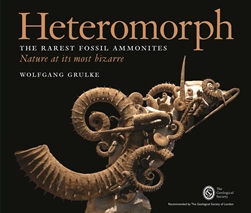Heteromorph The rarest fossil ammonites: Nature at its most bizarre
 I remember as a schoolboy collecting partially uncoiled ammonites from the Gault Clay at Folkestone on the Kent coast. Back then, as far as I recall, Late Cretaceous ammonites that departed from the normal planispiral coiling habit of ammonites were regarded at best as quite rare oddities and at worst deformed mutants that heralded the extinction of the order at the end of the Cretaceous. Wolfgang Grulke shows that the modern view of heteromorph ammonites is totally different. He describes how these ‘eccentric and bizarre members of the ammonites’ arose three times during the reign of the order and that ‘at a point during the mid-Cretaceous they represented almost half of all ammonite species in existence at that time’.
I remember as a schoolboy collecting partially uncoiled ammonites from the Gault Clay at Folkestone on the Kent coast. Back then, as far as I recall, Late Cretaceous ammonites that departed from the normal planispiral coiling habit of ammonites were regarded at best as quite rare oddities and at worst deformed mutants that heralded the extinction of the order at the end of the Cretaceous. Wolfgang Grulke shows that the modern view of heteromorph ammonites is totally different. He describes how these ‘eccentric and bizarre members of the ammonites’ arose three times during the reign of the order and that ‘at a point during the mid-Cretaceous they represented almost half of all ammonite species in existence at that time’.
Some years ago not long after I retired to Sherborne in Dorset I visited Wolfgang’s astounding private museum nearby which houses his collection of wonderful fossils, the majority of which are heteromorph ammonites. At the entrance to the museum there is a beautifully prepared surreal assemblage of heteromorphs, a photo of which dominates the cover of the book. At first it was hard to believe that the display was not a fanciful sculpture or an assemblage of several prepared specimens. Wolfgang explained – as he does in his book – that it wasn’t until ‘the tools and techniques used to extract and prepare fossil ammonites became much more sophisticated in the 1980s and 1990s that the full characteristics of the complex shapes of heteromorph ammonites could be revealed’. His museum is testament to his passion for heteromorphs (see ‘Cabinet of Curiosities’, Geoscientist October 2014) as is this large format book.
The book contains many stunning photographs that show the beauty and complexity of heteromorphs. It opens with a lay persons’ introduction to ammonites, but later chapters require some prior knowledge of geological – particularly stratigraphic – terms. These include a treatment of ‘sexy spirals’ including the golden ratio and Mandelbrot’s fractal geometry, the lifestyles, evolution and development of cephalopods and a description of the three heteromorph evolutionary experiments that occurred during the Late Triassic, Middle Jurassic and Late Jurassic to Cretaceous.
For each of these episodes there are panoramic environmental reconstructions of marine realms and adjacent coasts that showing the possible life habits of normal (‘monomorph’) and heteromorph ammonites. In the chapter devoted to ammonite lifestyles speculations are made about how heteromorphs might have lived and whether at least some, such as those shaped like paper clips, had their shells partially enveloped by fleshy mantles. The point is made that changes in coiling habit must inevitably have involved significant changes in the way the animals constructed their shells and would have also resulted in a change in the way they oriented themselves – so did their life habits change with their coiling habits? The evolutionary advantage of ‘going heteromorph’ remains to be explained.
‘Heteromorph’ is not just about unusual ammonites. In its later sections key heteromorph locations and collectors from around the world are described and cephalopod art through the ages reviewed. The book ends with an account of the collection, preparation and exhibition of the ‘million dollar art object’ which displays a two by four metre assemblage of over 300 ammonite and nautilus specimens weighing over 2500 kg. It was developed by French preparator Luc Ebbo, who has done much to reveal features of heteromorphs missed by earlier workers. Some purist palaeontologists find such commercialisation offensive, but Wolfgang Grulke’s book shows the importance of the work of ‘professional amateurs’ like him and the commercial collectors and preparators with whom he collaborates in advancing and promoting palaeontology.
Reviewed by Chris Wilson
HETEROMORPH: THE RAREST FOSSIL AMMONITES: NATURE AT ITS MOST BIZARRE by WOLFGANG GRULKE 2014. Published by At One Communications ISBN: 978-0-9929740-0-8 224pp (hbk) List Price £38.00